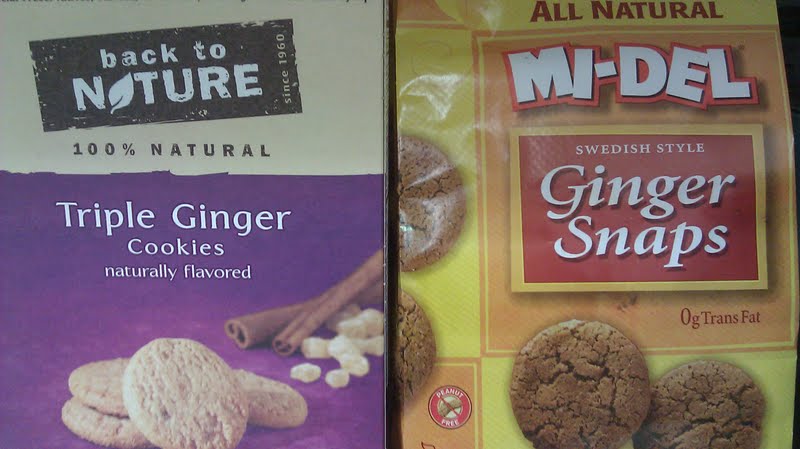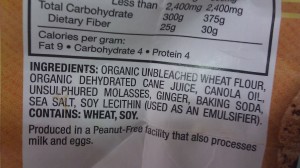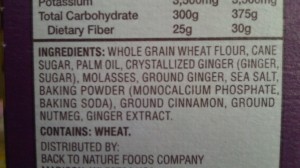Table of Contents[Hide][Show]

Does the snack aisle at your local healthfood store sometimes paralyze you? Do you look at the ingredients labels trying to decide exactly which cookies are the best ones to buy and yet feel overwhelmed by the numerous choices available all beckoning with the labels “all natural” or “organic”?
If so, you are not alone. This happens to me all the time.
Granted, I try my best to avoid the snack aisle at the healthfood store as much as possible and I don’t even go down the snack aisle at the supermarket because there are zero offerings there of any value. As much as is humanly possible, I prefer to make my own snacks for my family as this is always the most nutritious not to mention budget conscious way to go.
But let’s face it. Life happens and sometimes things just don’t go as scheduled.
All sorts of things from flat tires to your child’s badly scraped knee can occur to mess up your plans for baking an afternoon batch of cookies for school lunches the next day.
What to do then?
I thought it might be fun to analyze two different brands of cookies that I might consider buying when I am in search of a decent after lunch treat for my kids and far behind in my cookie baking duties.
Ginger snaps are one of my favorite store cookies as they are typically lower in sugar per serving than most other types of processed cookies. They also taste similar to the grain free ginger snaps I make myself, so buying a boxed version made with wheat flour on occasion is not going to all of a sudden cause my children to prefer the processed cookies over my own.
The picture at the top of this post is of the two brands of ginger snaps available at my local healthfood store.
Let’s analyze the ingredients labels of each and see if one of them is the clear winner over the other.
The Front of the Cookie Packages
From the front of the packages, you can’t really discern much if any difference. They both say “all natural” or “naturally flavored”.
The Mi-del brand says “Swedish Style” which I admit would draw me in as I like anything that suggests that the cookies are based on some traditional recipe. Of course, this may or may not be true. It’s all just marketing on the front of the package after all!
From a visual standpoint, the colors of the Back to Nature brand are far more appealing than the Mi-Del brand which are a bit harsh on the eye. Then again, purple is my favorite color so maybe that’s just my personal preference.
Ingredients Label Comparison
With the front of the packages not really telling us much, it is necessary to examine the ingredients labels to get the full story.

The first ingredient label to the right is of the Mi-Del Ginger Snaps.
I like that the wheat used is organic. That is a definite plus. In addition, the sweetener is organic dehydrated cane juice which is acceptable.
I don’t like that canola oil is used for the shortening as this is very potentially GM canola as it is not organic. In addition, canola oil is a polyunsaturated vegetable oil which almost certainly means that it is rancid.
Canola contains high amounts of omega 3 fats which are very delicate and can never be heated. You most certainly cannot bake cookies with it!. Use of canola in a boxed snackfood virtually ensures a rancid, health robbing product even if the ingredients are all organic.
Another item I don’t like is the use of soy lecithin. It is not organic soy lecithin, so the odds are good that it is GM soy given that over 90% of the soy in the the United States is genetically modified at present.
The second ingredient label to the right is of the Back to Nature Triple Ginger Cookies.

You’ll notice right away that the wheat flour used is not organic. The sweetener is also not as good quality because it is listed simply as cane sugar. It is not organic and it is not clear whether it is from dehydrated cane juice. It could easily be plain white sugar and probably is.
Not good.
So far, the Mi-Del Ginger Snaps are way in the lead.
However, the next ingredient changes the game entirely as palm oil is listed as the shortening.
This is very good as palm oil is a much healthier choice that the rancid canola oil used in the Mi-Del Ginger Snaps. Palm oil is acceptable for use in cookies and crackers. While coconut oil or butter would be best, palm oil can most definitely be considered a healthy fat.
Continuing down the ingredients label, all the other ingredients are excellent as well with no ominous “soy lecithin” listed.
Which Brand Did I Choose?
After analyzing the ingredients labels for these two boxes of ginger cookies, which brand did I ultimately choose?
If you guessed the Back to Nature Triple Ginger Cookies, you are correct!
The fact that the Mi-Del cookies are made with organic wheat flour and organic evaporated cane juice is insignificant compared with the fact that the Back To nature cookies use the much higher quality palm oil and no soy lecithin.
If you ever find yourself torn between two different brands of snack foods, always choose the one with the healthy fat like palm oil. The fat that is used is much more important than whether the flour or sugar used is organic.
In addition, go for the brand that clearly has no GMOs in it and that would be the Back to Nature brand as well.
Do all Back to Nature cookies get the thumbs up? Not necessarily.
I haven’t checked the labels on all the different cookies offered by this company, so don’t go and buy them without checking closely for yourself.
For that occasional need for a decent box of cookies from the store, though, the Triple Ginger Cookies pass with flying colors.
Sarah, The Healthy Home Economist








I just noticed Bugles are made with coconut oil…though they are probably made with GMO corn too. Still, that’s better than most chips.
Wow! Now that is progress! I still wouldn’t buy them for the non-organic corn, but things are making headway a bit at a time.
Hopefully, food manufacturers read blogs like this one and realize that Moms like me aren’t going to buy their garbage so they might as well fix it.
Thank you for this post! It was really helpful to me. I am a frazzled mommy raising little ones and sometimes don’t have time to bake from scratch, so this was an enlightening lesson.
P.S. I bought organic milk from the store today for the first time in over a year. My little kids don’t like the taste of “spring” milk from the farm (and I agree it does taste different this time of year). I really cringed to buy it and almost just wanted to give them water for a while instead, but they are begging for milk. What to do?
Try goat milk temporarily. It doesn’t have the same strong spring taste as grassfed cow milk for some reason. If you can’t get goat milk, then drink one of the milk substitutes I have blogged about (do a search at the top of the blog for “best milk substitutes”)
I’ve been in this exact situation many times trying to provide a “healthier” version of crap-snacks the rest of the class gets to send to my son’s nursery school (Nothing home-made allowed due to nut-free status!!!!). I’ve done the same trading off and rationalizing. It’s good to see I’m not alone. Thanks!
My understanding is that the problem with palm oil (or cottonseed oil) is that since a palm tree may not be categorized as “food” it may be treated with pesticides that are not food grade. Am I mistaken? Canola is definitely “out” due to the GMO component. Since fat cells store chemical pesticides, I try to favor organic fats over carbs. Tough subject! Thanks for bringing it up.
Palm trees are no spray in most cases. They can grow in terrible soil (aka sand).
Cottonseed oil is a whole other story. Very heavy spray crop.
Thanks for the thoughtful analysis. You convinced me.
When you are buying at the store, rarely is a food “perfect”. We have to learn to distinguish and prioritize which ingredients take precedence over others. Best to always make it yourself though, then you know it is indeed “perfect” 🙂
thanks! great info 🙂
excellent post, sarah! i find that people struggle with label reading and unfortunately it is a much needed skill in these uncertain times. yes, it is always best to make your own but we need to acknowledge that folks are just not going to do that 100% of the time – no one really can. thanks for a clear, well written illustration of how to discern and make an informed decision. as always, you deliver!
I was going to guess that you chose to make your own instead LOL!
Yes, that is the best solution for sure 🙂 I do buy store cookies on occasion though although they pale in comparison with the quality I make at home.
Now you made me want some gingersnaps!
I wish I could take you shopping with me, I am overwhelmed when I go…….